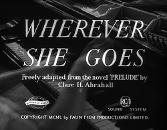 7927947774714300213.jpg
7927947774714300213.jpg
 7927947774714300213.jpg
7927947774714300213.jpg
Essentially a cinematic biography of Australian pianist Eileen Joyce's early life, Wherever She Goes attempts to 'dramatise the undramatic,' as one critic suggested (qtd '1946-1964' Celluloid Heroes, p. 12). The narrative concentrates on Joyce's bush childhood in Tasmania and the later years she spent in poverty in Kalgoorlie, Western Australia. It was there that her father attempted (and failed) to find a fortune in gold. The story is really about the struggles that the family and Eileen went through to develop her piano-playing skills. The real Eileen Joyce appears in both the opening and closing concert scenes of the film.
'Enduring popular narratives posit the 1950s as a time of gendered oppression and conservative stability. While previous historians have pointed to the social and political changes of the period, their work has understood culture as a passive reflector of these transformations. Through analysis of four Australian films, this article argues that the contemporary cultural landscape was a dynamic space that actively negotiated between competing ideals. Exploring the representation of distinct albeit legitimate models of masculinity in these films, this article reveals the complex and unsteady gender order unfolding in the cultural world of the 1950s.' (Publication abstract)
'Enduring popular narratives posit the 1950s as a time of gendered oppression and conservative stability. While previous historians have pointed to the social and political changes of the period, their work has understood culture as a passive reflector of these transformations. Through analysis of four Australian films, this article argues that the contemporary cultural landscape was a dynamic space that actively negotiated between competing ideals. Exploring the representation of distinct albeit legitimate models of masculinity in these films, this article reveals the complex and unsteady gender order unfolding in the cultural world of the 1950s.' (Publication abstract)